Blockchain Technology and Food Safety in UK Supply Chain Report
VerifiedAdded on 2021/06/17
|38
|7297
|262
Report
AI Summary
This report examines the application of blockchain technology to improve food safety and efficiency within the UK food supply chain. It begins with an overview of the research methodology, including the research onion, design, approach, and philosophy, emphasizing the use of a deductive approach and positivism philosophy. The data collection method involved primary data through a survey questionnaire with a focus on quantitative data analysis. The report discusses the 6Ts of Blockchain technology, including traceability, and analyzes the responses of managers in the food industry using the Likert scale. The findings indicate that blockchain technology has a significant positive impact on efficiency and traceability. The report also includes recommendations, future prospects, and a conclusion based on the data analysis and ethical considerations. The study involved a sample size of 15 workers from the UK food supply chain to investigate how blockchain technology can improve the supply chain operation.
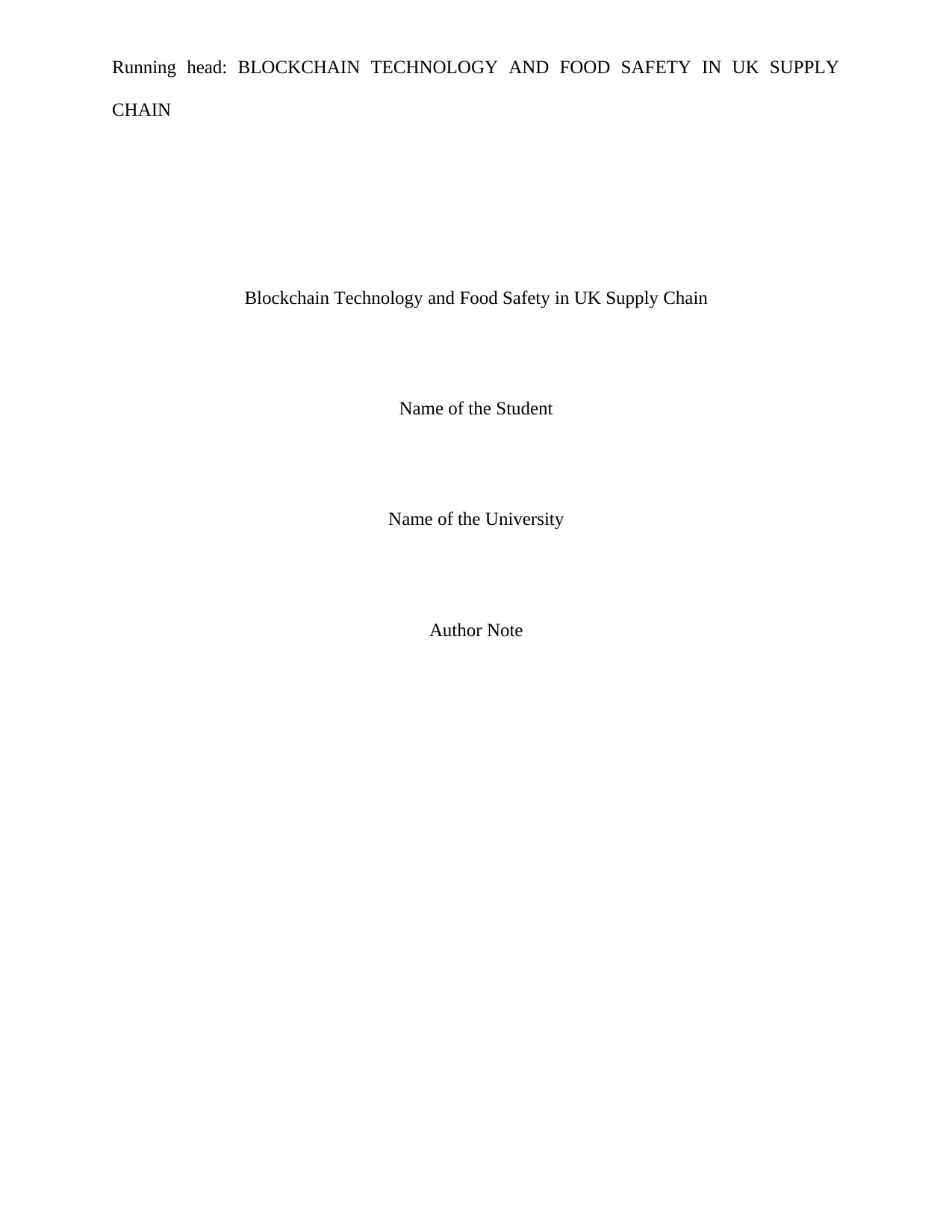
Running head: BLOCKCHAIN TECHNOLOGY AND FOOD SAFETY IN UK SUPPLY
CHAIN
Blockchain Technology and Food Safety in UK Supply Chain
Name of the Student
Name of the University
Author Note
CHAIN
Blockchain Technology and Food Safety in UK Supply Chain
Name of the Student
Name of the University
Author Note
Paraphrase This Document
Need a fresh take? Get an instant paraphrase of this document with our AI Paraphraser
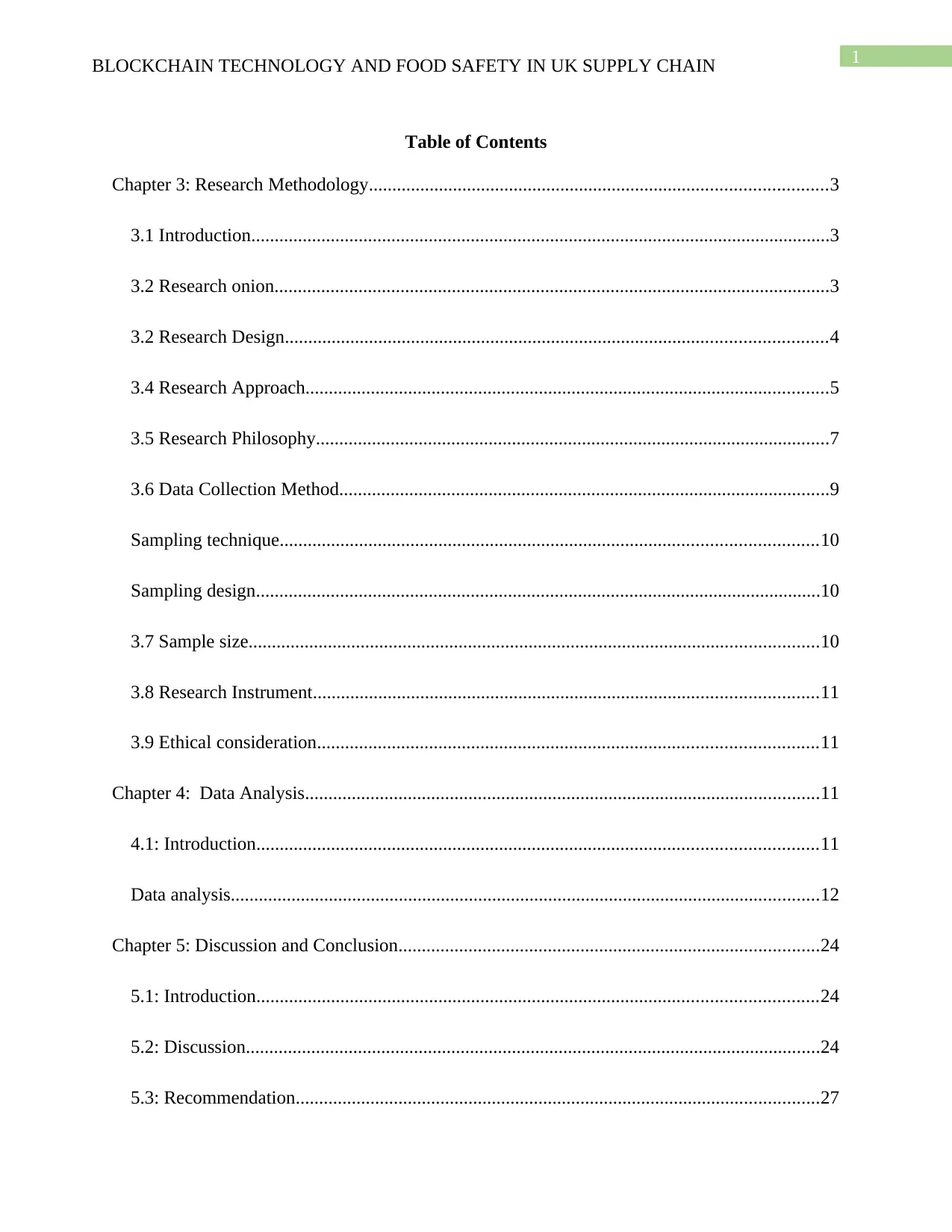
1BLOCKCHAIN TECHNOLOGY AND FOOD SAFETY IN UK SUPPLY CHAIN
Table of Contents
Chapter 3: Research Methodology..................................................................................................3
3.1 Introduction............................................................................................................................3
3.2 Research onion.......................................................................................................................3
3.2 Research Design....................................................................................................................4
3.4 Research Approach................................................................................................................5
3.5 Research Philosophy..............................................................................................................7
3.6 Data Collection Method.........................................................................................................9
Sampling technique...................................................................................................................10
Sampling design.........................................................................................................................10
3.7 Sample size..........................................................................................................................10
3.8 Research Instrument............................................................................................................11
3.9 Ethical consideration...........................................................................................................11
Chapter 4: Data Analysis..............................................................................................................11
4.1: Introduction........................................................................................................................11
Data analysis..............................................................................................................................12
Chapter 5: Discussion and Conclusion..........................................................................................24
5.1: Introduction........................................................................................................................24
5.2: Discussion...........................................................................................................................24
5.3: Recommendation................................................................................................................27
Table of Contents
Chapter 3: Research Methodology..................................................................................................3
3.1 Introduction............................................................................................................................3
3.2 Research onion.......................................................................................................................3
3.2 Research Design....................................................................................................................4
3.4 Research Approach................................................................................................................5
3.5 Research Philosophy..............................................................................................................7
3.6 Data Collection Method.........................................................................................................9
Sampling technique...................................................................................................................10
Sampling design.........................................................................................................................10
3.7 Sample size..........................................................................................................................10
3.8 Research Instrument............................................................................................................11
3.9 Ethical consideration...........................................................................................................11
Chapter 4: Data Analysis..............................................................................................................11
4.1: Introduction........................................................................................................................11
Data analysis..............................................................................................................................12
Chapter 5: Discussion and Conclusion..........................................................................................24
5.1: Introduction........................................................................................................................24
5.2: Discussion...........................................................................................................................24
5.3: Recommendation................................................................................................................27
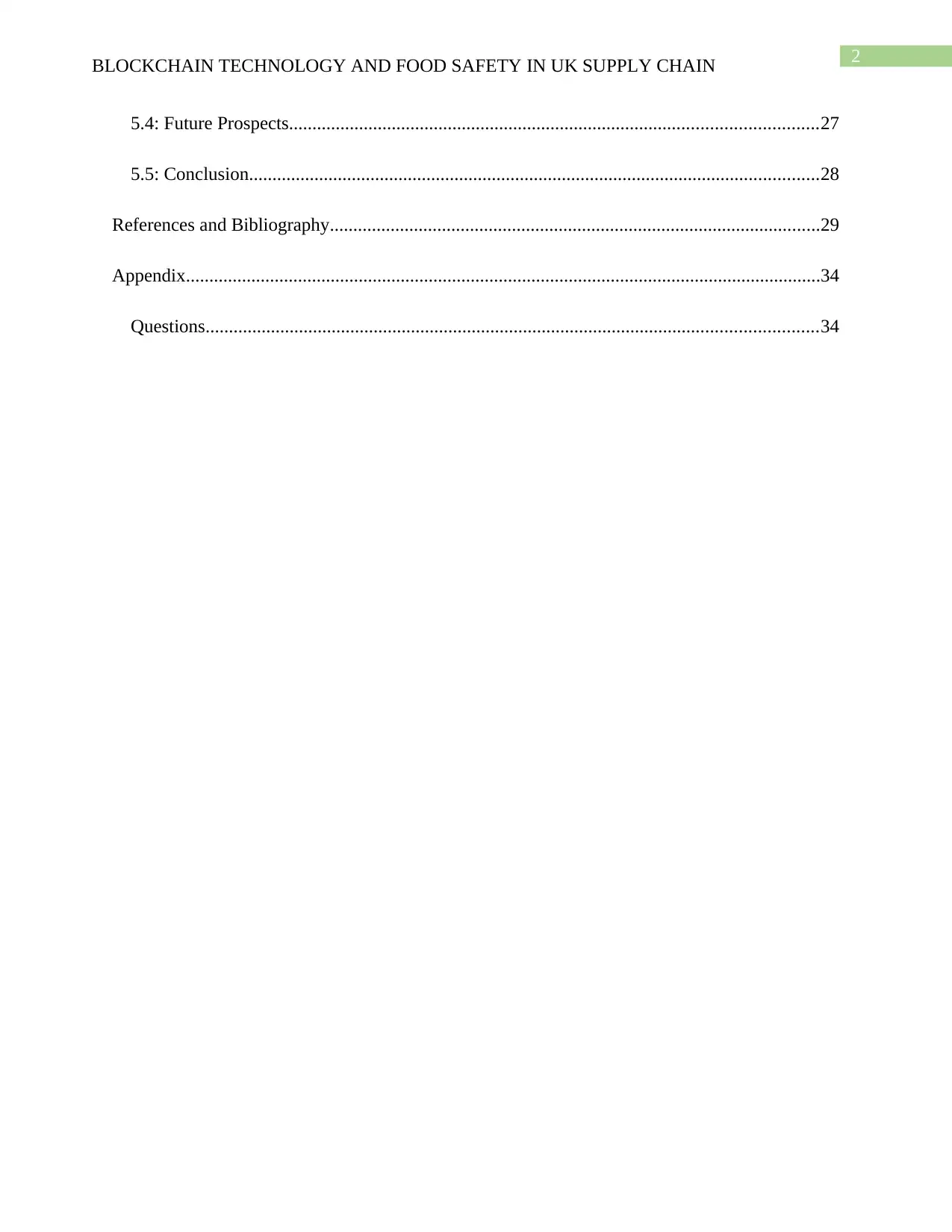
2
BLOCKCHAIN TECHNOLOGY AND FOOD SAFETY IN UK SUPPLY CHAIN
5.4: Future Prospects.................................................................................................................27
5.5: Conclusion..........................................................................................................................28
References and Bibliography.........................................................................................................29
Appendix........................................................................................................................................34
Questions...................................................................................................................................34
BLOCKCHAIN TECHNOLOGY AND FOOD SAFETY IN UK SUPPLY CHAIN
5.4: Future Prospects.................................................................................................................27
5.5: Conclusion..........................................................................................................................28
References and Bibliography.........................................................................................................29
Appendix........................................................................................................................................34
Questions...................................................................................................................................34
⊘ This is a preview!⊘
Do you want full access?
Subscribe today to unlock all pages.

Trusted by 1+ million students worldwide
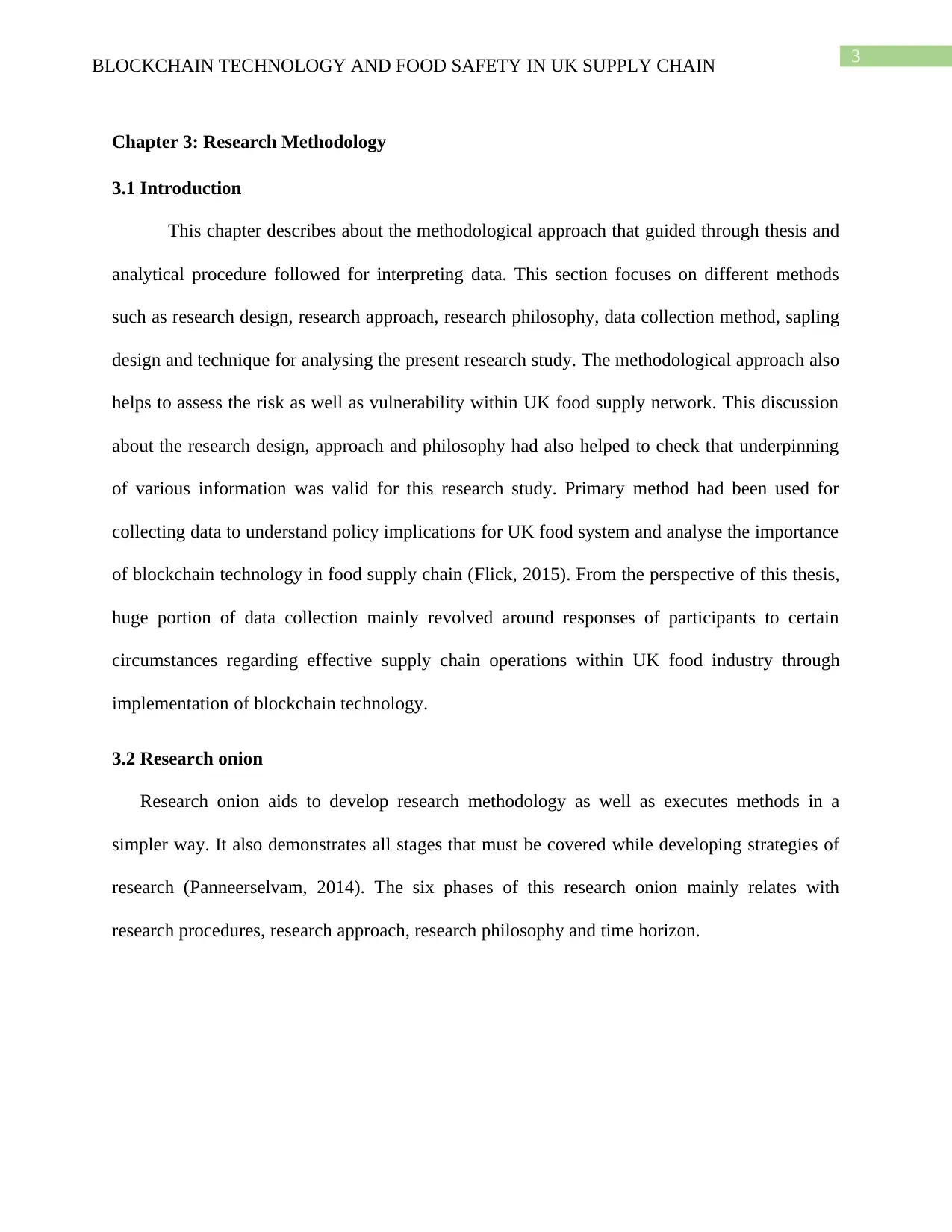
3
BLOCKCHAIN TECHNOLOGY AND FOOD SAFETY IN UK SUPPLY CHAIN
Chapter 3: Research Methodology
3.1 Introduction
This chapter describes about the methodological approach that guided through thesis and
analytical procedure followed for interpreting data. This section focuses on different methods
such as research design, research approach, research philosophy, data collection method, sapling
design and technique for analysing the present research study. The methodological approach also
helps to assess the risk as well as vulnerability within UK food supply network. This discussion
about the research design, approach and philosophy had also helped to check that underpinning
of various information was valid for this research study. Primary method had been used for
collecting data to understand policy implications for UK food system and analyse the importance
of blockchain technology in food supply chain (Flick, 2015). From the perspective of this thesis,
huge portion of data collection mainly revolved around responses of participants to certain
circumstances regarding effective supply chain operations within UK food industry through
implementation of blockchain technology.
3.2 Research onion
Research onion aids to develop research methodology as well as executes methods in a
simpler way. It also demonstrates all stages that must be covered while developing strategies of
research (Panneerselvam, 2014). The six phases of this research onion mainly relates with
research procedures, research approach, research philosophy and time horizon.
BLOCKCHAIN TECHNOLOGY AND FOOD SAFETY IN UK SUPPLY CHAIN
Chapter 3: Research Methodology
3.1 Introduction
This chapter describes about the methodological approach that guided through thesis and
analytical procedure followed for interpreting data. This section focuses on different methods
such as research design, research approach, research philosophy, data collection method, sapling
design and technique for analysing the present research study. The methodological approach also
helps to assess the risk as well as vulnerability within UK food supply network. This discussion
about the research design, approach and philosophy had also helped to check that underpinning
of various information was valid for this research study. Primary method had been used for
collecting data to understand policy implications for UK food system and analyse the importance
of blockchain technology in food supply chain (Flick, 2015). From the perspective of this thesis,
huge portion of data collection mainly revolved around responses of participants to certain
circumstances regarding effective supply chain operations within UK food industry through
implementation of blockchain technology.
3.2 Research onion
Research onion aids to develop research methodology as well as executes methods in a
simpler way. It also demonstrates all stages that must be covered while developing strategies of
research (Panneerselvam, 2014). The six phases of this research onion mainly relates with
research procedures, research approach, research philosophy and time horizon.
Paraphrase This Document
Need a fresh take? Get an instant paraphrase of this document with our AI Paraphraser
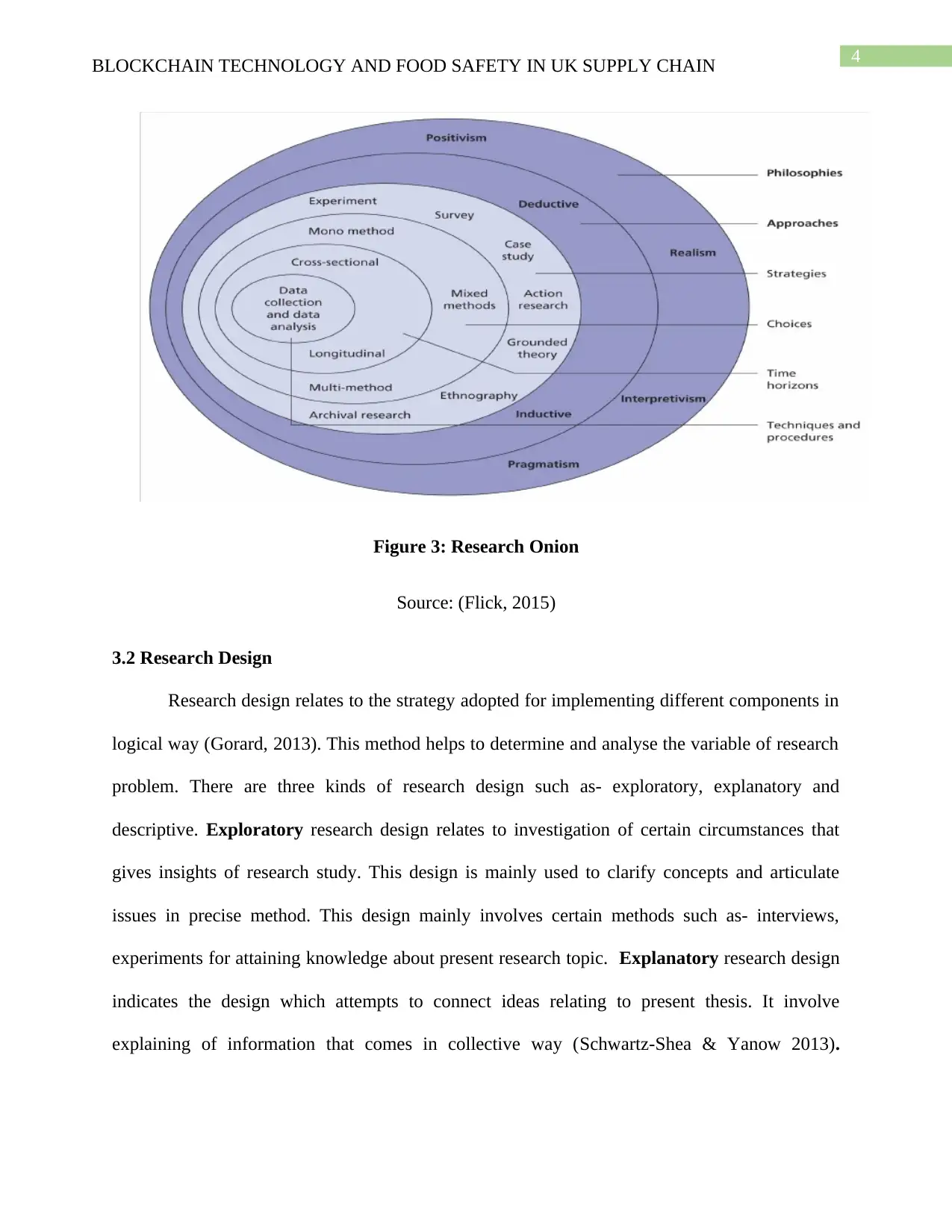
4
BLOCKCHAIN TECHNOLOGY AND FOOD SAFETY IN UK SUPPLY CHAIN
Figure 3: Research Onion
Source: (Flick, 2015)
3.2 Research Design
Research design relates to the strategy adopted for implementing different components in
logical way (Gorard, 2013). This method helps to determine and analyse the variable of research
problem. There are three kinds of research design such as- exploratory, explanatory and
descriptive. Exploratory research design relates to investigation of certain circumstances that
gives insights of research study. This design is mainly used to clarify concepts and articulate
issues in precise method. This design mainly involves certain methods such as- interviews,
experiments for attaining knowledge about present research topic. Explanatory research design
indicates the design which attempts to connect ideas relating to present thesis. It involve
explaining of information that comes in collective way (Schwartz-Shea & Yanow 2013).
BLOCKCHAIN TECHNOLOGY AND FOOD SAFETY IN UK SUPPLY CHAIN
Figure 3: Research Onion
Source: (Flick, 2015)
3.2 Research Design
Research design relates to the strategy adopted for implementing different components in
logical way (Gorard, 2013). This method helps to determine and analyse the variable of research
problem. There are three kinds of research design such as- exploratory, explanatory and
descriptive. Exploratory research design relates to investigation of certain circumstances that
gives insights of research study. This design is mainly used to clarify concepts and articulate
issues in precise method. This design mainly involves certain methods such as- interviews,
experiments for attaining knowledge about present research topic. Explanatory research design
indicates the design which attempts to connect ideas relating to present thesis. It involve
explaining of information that comes in collective way (Schwartz-Shea & Yanow 2013).
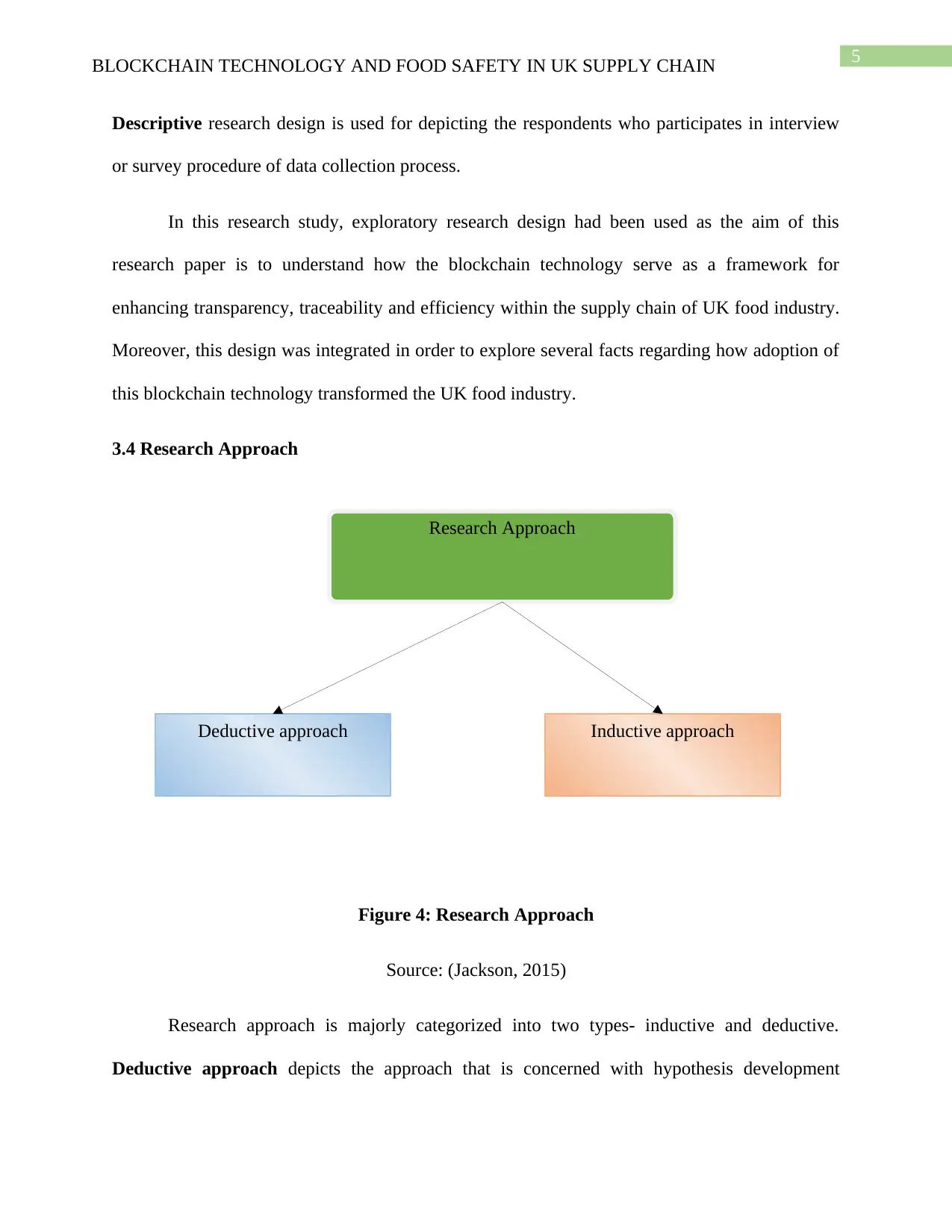
Research Approach
Deductive approach Inductive approach
5
BLOCKCHAIN TECHNOLOGY AND FOOD SAFETY IN UK SUPPLY CHAIN
Descriptive research design is used for depicting the respondents who participates in interview
or survey procedure of data collection process.
In this research study, exploratory research design had been used as the aim of this
research paper is to understand how the blockchain technology serve as a framework for
enhancing transparency, traceability and efficiency within the supply chain of UK food industry.
Moreover, this design was integrated in order to explore several facts regarding how adoption of
this blockchain technology transformed the UK food industry.
3.4 Research Approach
Figure 4: Research Approach
Source: (Jackson, 2015)
Research approach is majorly categorized into two types- inductive and deductive.
Deductive approach depicts the approach that is concerned with hypothesis development
Deductive approach Inductive approach
5
BLOCKCHAIN TECHNOLOGY AND FOOD SAFETY IN UK SUPPLY CHAIN
Descriptive research design is used for depicting the respondents who participates in interview
or survey procedure of data collection process.
In this research study, exploratory research design had been used as the aim of this
research paper is to understand how the blockchain technology serve as a framework for
enhancing transparency, traceability and efficiency within the supply chain of UK food industry.
Moreover, this design was integrated in order to explore several facts regarding how adoption of
this blockchain technology transformed the UK food industry.
3.4 Research Approach
Figure 4: Research Approach
Source: (Jackson, 2015)
Research approach is majorly categorized into two types- inductive and deductive.
Deductive approach depicts the approach that is concerned with hypothesis development
⊘ This is a preview!⊘
Do you want full access?
Subscribe today to unlock all pages.

Trusted by 1+ million students worldwide
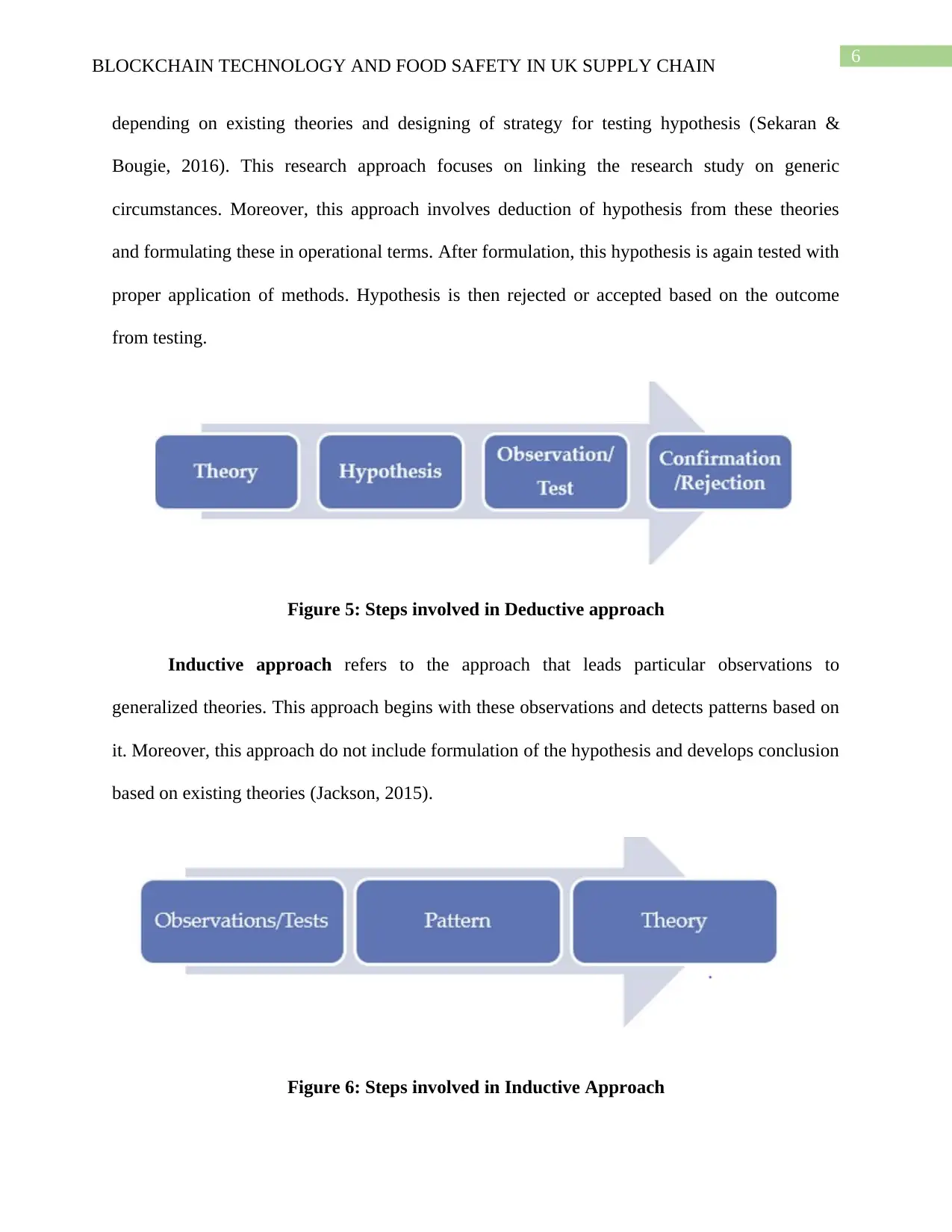
6
BLOCKCHAIN TECHNOLOGY AND FOOD SAFETY IN UK SUPPLY CHAIN
depending on existing theories and designing of strategy for testing hypothesis (Sekaran &
Bougie, 2016). This research approach focuses on linking the research study on generic
circumstances. Moreover, this approach involves deduction of hypothesis from these theories
and formulating these in operational terms. After formulation, this hypothesis is again tested with
proper application of methods. Hypothesis is then rejected or accepted based on the outcome
from testing.
Figure 5: Steps involved in Deductive approach
Inductive approach refers to the approach that leads particular observations to
generalized theories. This approach begins with these observations and detects patterns based on
it. Moreover, this approach do not include formulation of the hypothesis and develops conclusion
based on existing theories (Jackson, 2015).
Figure 6: Steps involved in Inductive Approach
BLOCKCHAIN TECHNOLOGY AND FOOD SAFETY IN UK SUPPLY CHAIN
depending on existing theories and designing of strategy for testing hypothesis (Sekaran &
Bougie, 2016). This research approach focuses on linking the research study on generic
circumstances. Moreover, this approach involves deduction of hypothesis from these theories
and formulating these in operational terms. After formulation, this hypothesis is again tested with
proper application of methods. Hypothesis is then rejected or accepted based on the outcome
from testing.
Figure 5: Steps involved in Deductive approach
Inductive approach refers to the approach that leads particular observations to
generalized theories. This approach begins with these observations and detects patterns based on
it. Moreover, this approach do not include formulation of the hypothesis and develops conclusion
based on existing theories (Jackson, 2015).
Figure 6: Steps involved in Inductive Approach
Paraphrase This Document
Need a fresh take? Get an instant paraphrase of this document with our AI Paraphraser
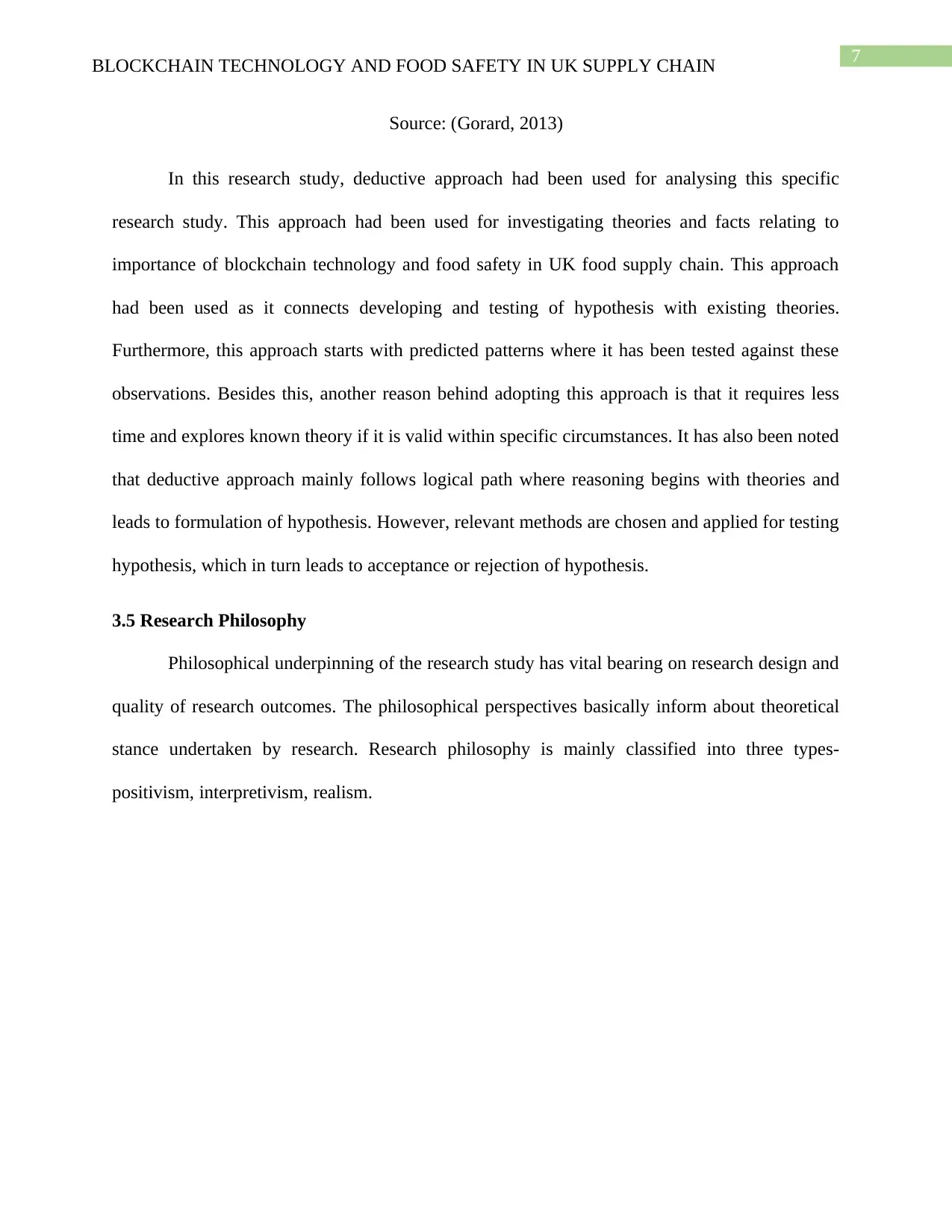
7
BLOCKCHAIN TECHNOLOGY AND FOOD SAFETY IN UK SUPPLY CHAIN
Source: (Gorard, 2013)
In this research study, deductive approach had been used for analysing this specific
research study. This approach had been used for investigating theories and facts relating to
importance of blockchain technology and food safety in UK food supply chain. This approach
had been used as it connects developing and testing of hypothesis with existing theories.
Furthermore, this approach starts with predicted patterns where it has been tested against these
observations. Besides this, another reason behind adopting this approach is that it requires less
time and explores known theory if it is valid within specific circumstances. It has also been noted
that deductive approach mainly follows logical path where reasoning begins with theories and
leads to formulation of hypothesis. However, relevant methods are chosen and applied for testing
hypothesis, which in turn leads to acceptance or rejection of hypothesis.
3.5 Research Philosophy
Philosophical underpinning of the research study has vital bearing on research design and
quality of research outcomes. The philosophical perspectives basically inform about theoretical
stance undertaken by research. Research philosophy is mainly classified into three types-
positivism, interpretivism, realism.
BLOCKCHAIN TECHNOLOGY AND FOOD SAFETY IN UK SUPPLY CHAIN
Source: (Gorard, 2013)
In this research study, deductive approach had been used for analysing this specific
research study. This approach had been used for investigating theories and facts relating to
importance of blockchain technology and food safety in UK food supply chain. This approach
had been used as it connects developing and testing of hypothesis with existing theories.
Furthermore, this approach starts with predicted patterns where it has been tested against these
observations. Besides this, another reason behind adopting this approach is that it requires less
time and explores known theory if it is valid within specific circumstances. It has also been noted
that deductive approach mainly follows logical path where reasoning begins with theories and
leads to formulation of hypothesis. However, relevant methods are chosen and applied for testing
hypothesis, which in turn leads to acceptance or rejection of hypothesis.
3.5 Research Philosophy
Philosophical underpinning of the research study has vital bearing on research design and
quality of research outcomes. The philosophical perspectives basically inform about theoretical
stance undertaken by research. Research philosophy is mainly classified into three types-
positivism, interpretivism, realism.
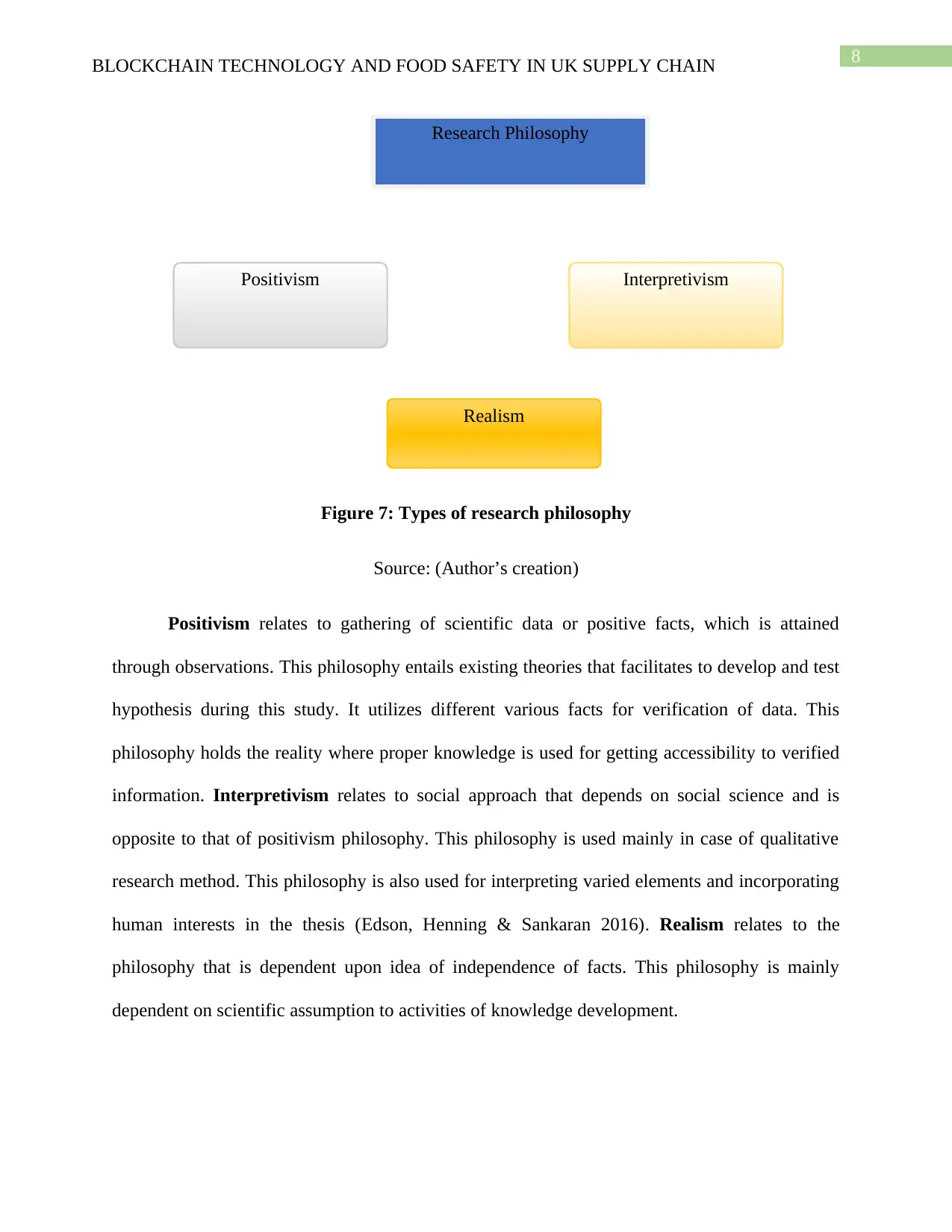
Research Philosophy
Positivism
Realism
Interpretivism
8
BLOCKCHAIN TECHNOLOGY AND FOOD SAFETY IN UK SUPPLY CHAIN
Figure 7: Types of research philosophy
Source: (Author’s creation)
Positivism relates to gathering of scientific data or positive facts, which is attained
through observations. This philosophy entails existing theories that facilitates to develop and test
hypothesis during this study. It utilizes different various facts for verification of data. This
philosophy holds the reality where proper knowledge is used for getting accessibility to verified
information. Interpretivism relates to social approach that depends on social science and is
opposite to that of positivism philosophy. This philosophy is used mainly in case of qualitative
research method. This philosophy is also used for interpreting varied elements and incorporating
human interests in the thesis (Edson, Henning & Sankaran 2016). Realism relates to the
philosophy that is dependent upon idea of independence of facts. This philosophy is mainly
dependent on scientific assumption to activities of knowledge development.
Positivism
Realism
Interpretivism
8
BLOCKCHAIN TECHNOLOGY AND FOOD SAFETY IN UK SUPPLY CHAIN
Figure 7: Types of research philosophy
Source: (Author’s creation)
Positivism relates to gathering of scientific data or positive facts, which is attained
through observations. This philosophy entails existing theories that facilitates to develop and test
hypothesis during this study. It utilizes different various facts for verification of data. This
philosophy holds the reality where proper knowledge is used for getting accessibility to verified
information. Interpretivism relates to social approach that depends on social science and is
opposite to that of positivism philosophy. This philosophy is used mainly in case of qualitative
research method. This philosophy is also used for interpreting varied elements and incorporating
human interests in the thesis (Edson, Henning & Sankaran 2016). Realism relates to the
philosophy that is dependent upon idea of independence of facts. This philosophy is mainly
dependent on scientific assumption to activities of knowledge development.
⊘ This is a preview!⊘
Do you want full access?
Subscribe today to unlock all pages.

Trusted by 1+ million students worldwide
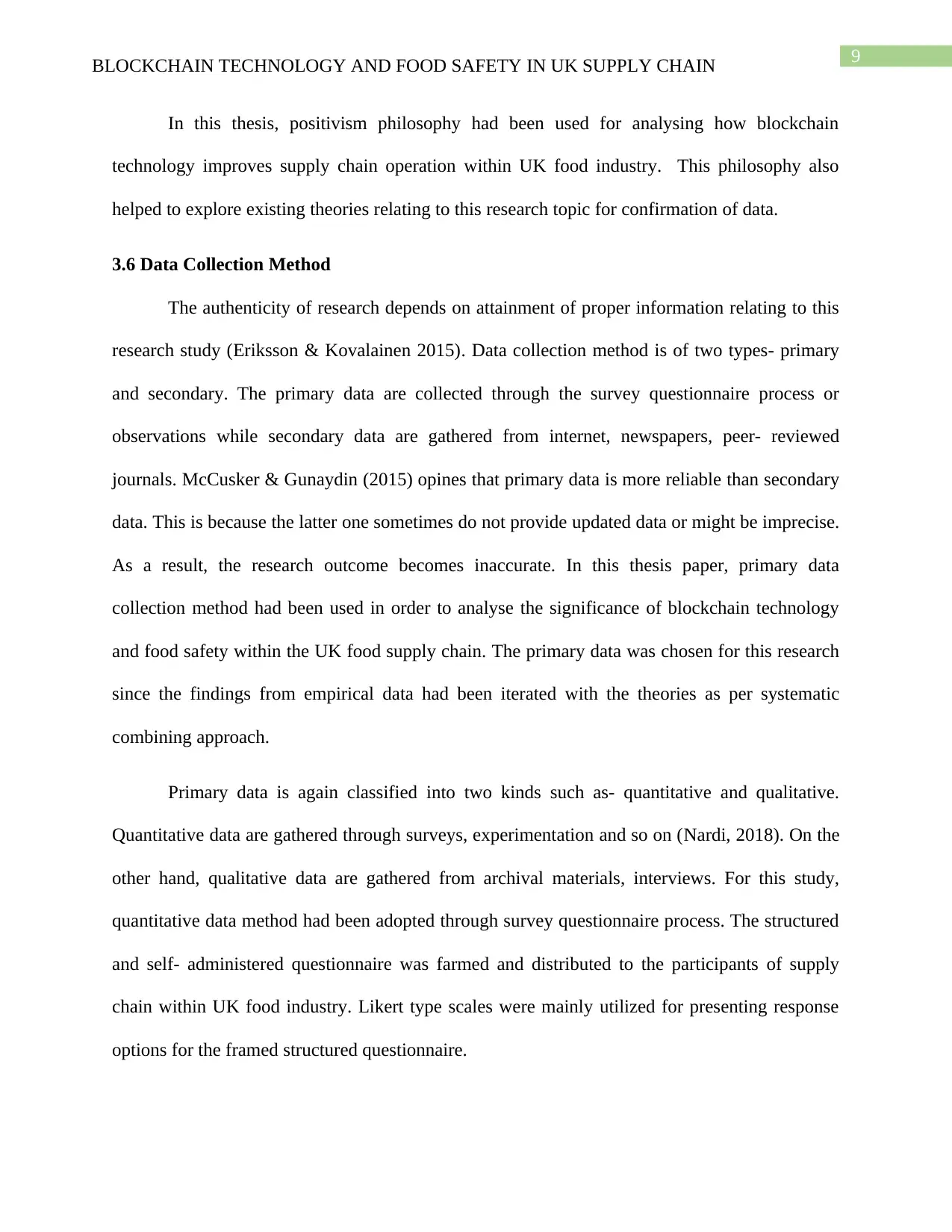
9
BLOCKCHAIN TECHNOLOGY AND FOOD SAFETY IN UK SUPPLY CHAIN
In this thesis, positivism philosophy had been used for analysing how blockchain
technology improves supply chain operation within UK food industry. This philosophy also
helped to explore existing theories relating to this research topic for confirmation of data.
3.6 Data Collection Method
The authenticity of research depends on attainment of proper information relating to this
research study (Eriksson & Kovalainen 2015). Data collection method is of two types- primary
and secondary. The primary data are collected through the survey questionnaire process or
observations while secondary data are gathered from internet, newspapers, peer- reviewed
journals. McCusker & Gunaydin (2015) opines that primary data is more reliable than secondary
data. This is because the latter one sometimes do not provide updated data or might be imprecise.
As a result, the research outcome becomes inaccurate. In this thesis paper, primary data
collection method had been used in order to analyse the significance of blockchain technology
and food safety within the UK food supply chain. The primary data was chosen for this research
since the findings from empirical data had been iterated with the theories as per systematic
combining approach.
Primary data is again classified into two kinds such as- quantitative and qualitative.
Quantitative data are gathered through surveys, experimentation and so on (Nardi, 2018). On the
other hand, qualitative data are gathered from archival materials, interviews. For this study,
quantitative data method had been adopted through survey questionnaire process. The structured
and self- administered questionnaire was farmed and distributed to the participants of supply
chain within UK food industry. Likert type scales were mainly utilized for presenting response
options for the framed structured questionnaire.
BLOCKCHAIN TECHNOLOGY AND FOOD SAFETY IN UK SUPPLY CHAIN
In this thesis, positivism philosophy had been used for analysing how blockchain
technology improves supply chain operation within UK food industry. This philosophy also
helped to explore existing theories relating to this research topic for confirmation of data.
3.6 Data Collection Method
The authenticity of research depends on attainment of proper information relating to this
research study (Eriksson & Kovalainen 2015). Data collection method is of two types- primary
and secondary. The primary data are collected through the survey questionnaire process or
observations while secondary data are gathered from internet, newspapers, peer- reviewed
journals. McCusker & Gunaydin (2015) opines that primary data is more reliable than secondary
data. This is because the latter one sometimes do not provide updated data or might be imprecise.
As a result, the research outcome becomes inaccurate. In this thesis paper, primary data
collection method had been used in order to analyse the significance of blockchain technology
and food safety within the UK food supply chain. The primary data was chosen for this research
since the findings from empirical data had been iterated with the theories as per systematic
combining approach.
Primary data is again classified into two kinds such as- quantitative and qualitative.
Quantitative data are gathered through surveys, experimentation and so on (Nardi, 2018). On the
other hand, qualitative data are gathered from archival materials, interviews. For this study,
quantitative data method had been adopted through survey questionnaire process. The structured
and self- administered questionnaire was farmed and distributed to the participants of supply
chain within UK food industry. Likert type scales were mainly utilized for presenting response
options for the framed structured questionnaire.
Paraphrase This Document
Need a fresh take? Get an instant paraphrase of this document with our AI Paraphraser
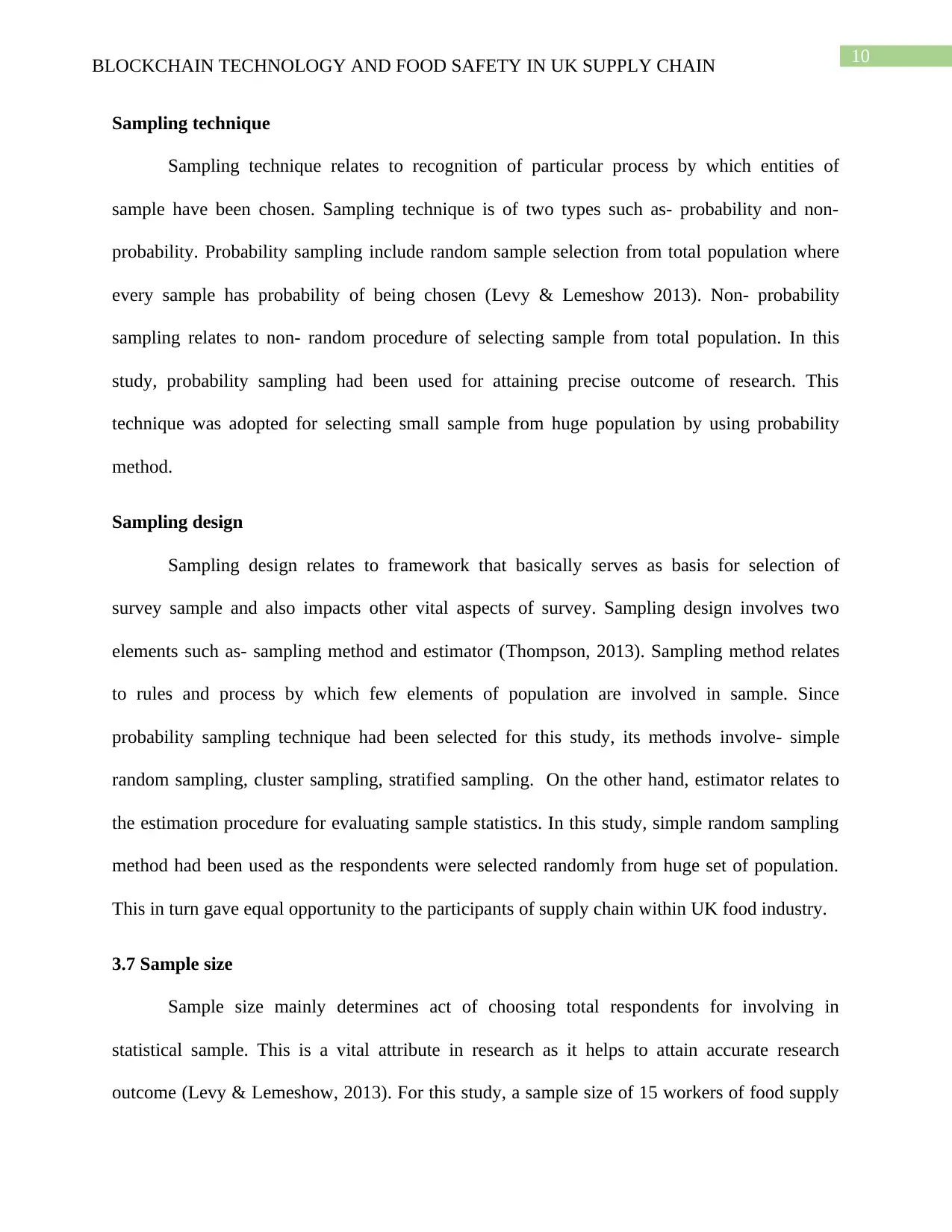
10
BLOCKCHAIN TECHNOLOGY AND FOOD SAFETY IN UK SUPPLY CHAIN
Sampling technique
Sampling technique relates to recognition of particular process by which entities of
sample have been chosen. Sampling technique is of two types such as- probability and non-
probability. Probability sampling include random sample selection from total population where
every sample has probability of being chosen (Levy & Lemeshow 2013). Non- probability
sampling relates to non- random procedure of selecting sample from total population. In this
study, probability sampling had been used for attaining precise outcome of research. This
technique was adopted for selecting small sample from huge population by using probability
method.
Sampling design
Sampling design relates to framework that basically serves as basis for selection of
survey sample and also impacts other vital aspects of survey. Sampling design involves two
elements such as- sampling method and estimator (Thompson, 2013). Sampling method relates
to rules and process by which few elements of population are involved in sample. Since
probability sampling technique had been selected for this study, its methods involve- simple
random sampling, cluster sampling, stratified sampling. On the other hand, estimator relates to
the estimation procedure for evaluating sample statistics. In this study, simple random sampling
method had been used as the respondents were selected randomly from huge set of population.
This in turn gave equal opportunity to the participants of supply chain within UK food industry.
3.7 Sample size
Sample size mainly determines act of choosing total respondents for involving in
statistical sample. This is a vital attribute in research as it helps to attain accurate research
outcome (Levy & Lemeshow, 2013). For this study, a sample size of 15 workers of food supply
BLOCKCHAIN TECHNOLOGY AND FOOD SAFETY IN UK SUPPLY CHAIN
Sampling technique
Sampling technique relates to recognition of particular process by which entities of
sample have been chosen. Sampling technique is of two types such as- probability and non-
probability. Probability sampling include random sample selection from total population where
every sample has probability of being chosen (Levy & Lemeshow 2013). Non- probability
sampling relates to non- random procedure of selecting sample from total population. In this
study, probability sampling had been used for attaining precise outcome of research. This
technique was adopted for selecting small sample from huge population by using probability
method.
Sampling design
Sampling design relates to framework that basically serves as basis for selection of
survey sample and also impacts other vital aspects of survey. Sampling design involves two
elements such as- sampling method and estimator (Thompson, 2013). Sampling method relates
to rules and process by which few elements of population are involved in sample. Since
probability sampling technique had been selected for this study, its methods involve- simple
random sampling, cluster sampling, stratified sampling. On the other hand, estimator relates to
the estimation procedure for evaluating sample statistics. In this study, simple random sampling
method had been used as the respondents were selected randomly from huge set of population.
This in turn gave equal opportunity to the participants of supply chain within UK food industry.
3.7 Sample size
Sample size mainly determines act of choosing total respondents for involving in
statistical sample. This is a vital attribute in research as it helps to attain accurate research
outcome (Levy & Lemeshow, 2013). For this study, a sample size of 15 workers of food supply
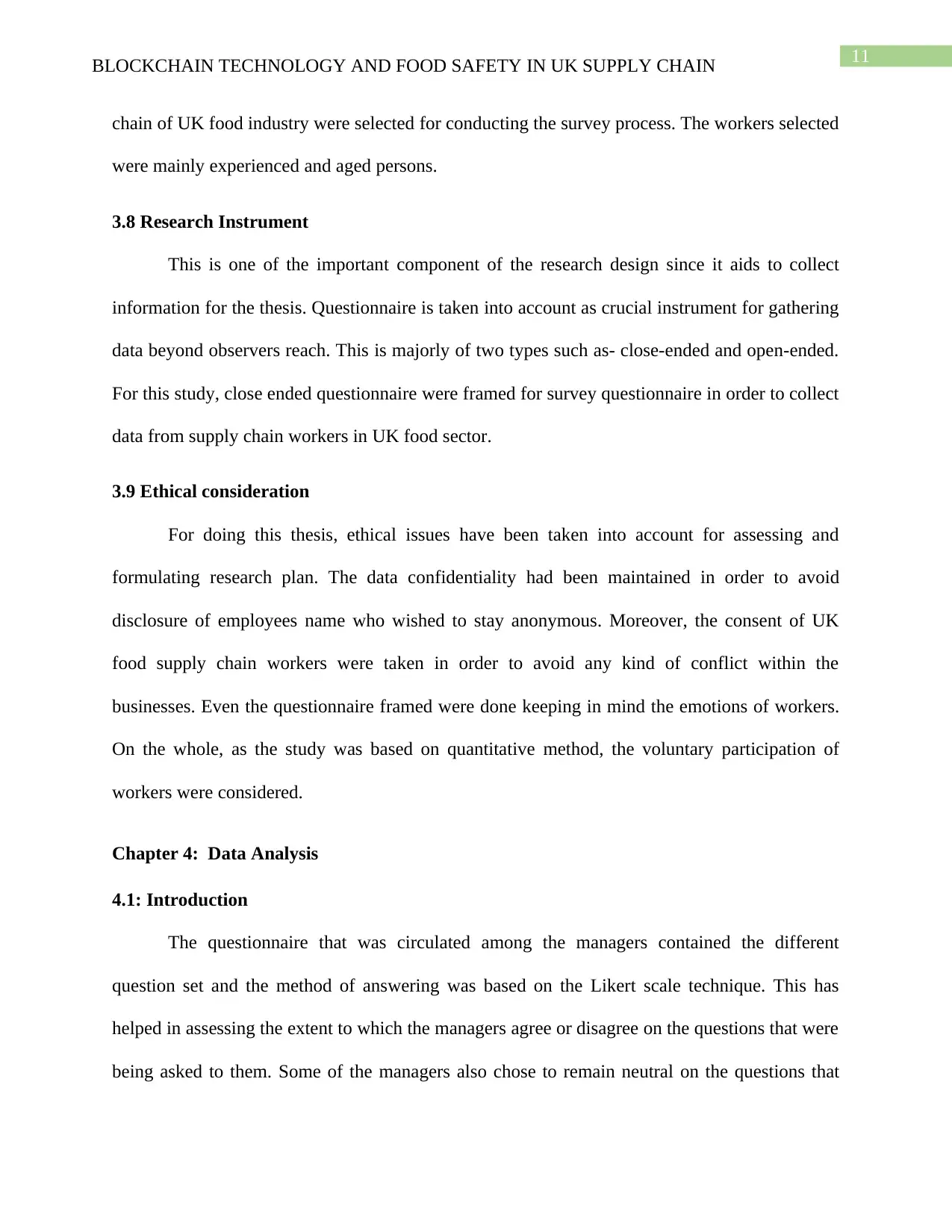
11
BLOCKCHAIN TECHNOLOGY AND FOOD SAFETY IN UK SUPPLY CHAIN
chain of UK food industry were selected for conducting the survey process. The workers selected
were mainly experienced and aged persons.
3.8 Research Instrument
This is one of the important component of the research design since it aids to collect
information for the thesis. Questionnaire is taken into account as crucial instrument for gathering
data beyond observers reach. This is majorly of two types such as- close-ended and open-ended.
For this study, close ended questionnaire were framed for survey questionnaire in order to collect
data from supply chain workers in UK food sector.
3.9 Ethical consideration
For doing this thesis, ethical issues have been taken into account for assessing and
formulating research plan. The data confidentiality had been maintained in order to avoid
disclosure of employees name who wished to stay anonymous. Moreover, the consent of UK
food supply chain workers were taken in order to avoid any kind of conflict within the
businesses. Even the questionnaire framed were done keeping in mind the emotions of workers.
On the whole, as the study was based on quantitative method, the voluntary participation of
workers were considered.
Chapter 4: Data Analysis
4.1: Introduction
The questionnaire that was circulated among the managers contained the different
question set and the method of answering was based on the Likert scale technique. This has
helped in assessing the extent to which the managers agree or disagree on the questions that were
being asked to them. Some of the managers also chose to remain neutral on the questions that
BLOCKCHAIN TECHNOLOGY AND FOOD SAFETY IN UK SUPPLY CHAIN
chain of UK food industry were selected for conducting the survey process. The workers selected
were mainly experienced and aged persons.
3.8 Research Instrument
This is one of the important component of the research design since it aids to collect
information for the thesis. Questionnaire is taken into account as crucial instrument for gathering
data beyond observers reach. This is majorly of two types such as- close-ended and open-ended.
For this study, close ended questionnaire were framed for survey questionnaire in order to collect
data from supply chain workers in UK food sector.
3.9 Ethical consideration
For doing this thesis, ethical issues have been taken into account for assessing and
formulating research plan. The data confidentiality had been maintained in order to avoid
disclosure of employees name who wished to stay anonymous. Moreover, the consent of UK
food supply chain workers were taken in order to avoid any kind of conflict within the
businesses. Even the questionnaire framed were done keeping in mind the emotions of workers.
On the whole, as the study was based on quantitative method, the voluntary participation of
workers were considered.
Chapter 4: Data Analysis
4.1: Introduction
The questionnaire that was circulated among the managers contained the different
question set and the method of answering was based on the Likert scale technique. This has
helped in assessing the extent to which the managers agree or disagree on the questions that were
being asked to them. Some of the managers also chose to remain neutral on the questions that
⊘ This is a preview!⊘
Do you want full access?
Subscribe today to unlock all pages.

Trusted by 1+ million students worldwide
1 out of 38
Related Documents
Your All-in-One AI-Powered Toolkit for Academic Success.
+13062052269
info@desklib.com
Available 24*7 on WhatsApp / Email
![[object Object]](/_next/static/media/star-bottom.7253800d.svg)
Unlock your academic potential
Copyright © 2020–2025 A2Z Services. All Rights Reserved. Developed and managed by ZUCOL.




